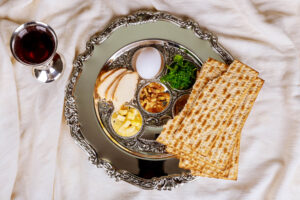Maundy Thursday (also known as Holy Thursday) commemorates the Last Supper, where Christ lays out the model for the Eucharist or Holy Communion.
During the meal, Jesus predicted the events that would immediately follow, including his betrayal, the Denial of Peter, and his death and resurrection.
A Seder Meal is often held.
The Seder is the historic Jewish feast that was held on the night before Passover. Jesus and his disciples would have been meeting that night for such a feast of remembrance.
What is a Seder Plate?
 The Passover Seder Plate is a special plate which contains symbolic foods that are eaten or displayed at the Passover Seder, which is a Jewish holiday celebrated in the spring. Every piece of food on the plate has its own individual symbolic meaning.
The Passover Seder Plate is a special plate which contains symbolic foods that are eaten or displayed at the Passover Seder, which is a Jewish holiday celebrated in the spring. Every piece of food on the plate has its own individual symbolic meaning.
The Seder Plate is the focal point of the first two nights of Passover. The Seder tells the story of Exodus through the senses of sight, taste, and feeling.
The plate traditionally has five or six items which each represent a part or multiple parts of the Passover story.
Stripping of the Altar
This tradition developed because the altar guilds needed to strip the altar after Maundy Thursday in preparation for the bare, stark altar on Good Friday. People stayed after worship to observe this, and it was soon experienced as a powerful spiritual moment.
Today, the stripping and washing of the altar is often an integral part of Maundy Thursday.
Traditionally, there would be no Eucharist on Good Friday. But in some places, the sacrament is reserved from Maundy Thursday to be administered on Good Friday.
Either way, Maundy Thursday ends with the starkness of the empty, bare altar. Our souls are bare as well, as we begin to walk through the rest of the weekend.
Worshipping in a Somber Tone
As we enter the Great Three Days, we need to be open to silence, to reverence, and to a somber tone.
One thing I appreciate about Anglicanism is how it doesn’t shy away from these modes. In some traditions, the tone is always either happy or sad. But in the classic Christian tradition, there is another “key” we can worship in.
For example, during the Stripping of the Altar. We sit in silence and we depart in silence. This is not intended to be sad or depressing. It is contemplative, reflective, and reverent. If that’s new for you, try it out this year. Just experience it openly and then reflect on your experience later.
Maundy Thursday doesn’t end on Maundy Thursday
This New Commandment and the Holy Meal are instituted this night, not completed. Jesus was shaping his disciples around servanthood and fellowship. Serving one another, serving the least and the outcast, and seeing ourselves not as masters but as those who serve. And this servanthood is grounded on holy fellowship, with God and man at the table.
Maundy Thursday was only the beginning! We are called to be Maundy Christians every day.